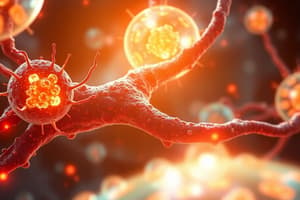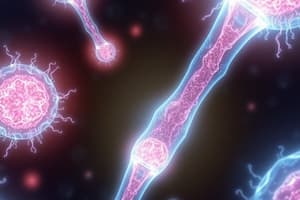Podcast
Questions and Answers
Which process did Lynn Margulis propose for the evolution of mitochondria and plastids?
Which process did Lynn Margulis propose for the evolution of mitochondria and plastids?
- Exocytosis
- Active transport
- Mutation
- Endosymbiosis (correct)
What is a common feature of both mitochondria and plastids that supports the endosymbiosis theory?
What is a common feature of both mitochondria and plastids that supports the endosymbiosis theory?
- Absence of enzymes
- Presence of ribosomes
- Double membrane structure (correct)
- Lack of DNA
Which organelles are believed to have evolved from Bacteria based on the endosymbiosis theory?
Which organelles are believed to have evolved from Bacteria based on the endosymbiosis theory?
- Mitochondria and plastids (correct)
- Chloroplasts and ribosomes
- Nucleus and Golgi apparatus
- Mitochondria and lysosomes
What is a function commonly associated with plastids?
What is a function commonly associated with plastids?
One common feature between mitochondria and plastids is their ability to:
One common feature between mitochondria and plastids is their ability to:
Which of the following is NOT a common feature between mitochondria and plastids?
Which of the following is NOT a common feature between mitochondria and plastids?
What is the main reason why the single cell photosynthetic organisms extracted from the lake are concluded to be eukaryotes and not bacteria?
What is the main reason why the single cell photosynthetic organisms extracted from the lake are concluded to be eukaryotes and not bacteria?
Which feature of plastids contradicts the belief that they only have a single purpose of photosynthesis?
Which feature of plastids contradicts the belief that they only have a single purpose of photosynthesis?
Which statement best supports the endosymbiosis theory regarding the origin of plastids?
Which statement best supports the endosymbiosis theory regarding the origin of plastids?
Which feature of plastids differentiates them from bacteria and supports their eukaryotic nature?
Which feature of plastids differentiates them from bacteria and supports their eukaryotic nature?
What feature of mitochondria enables them to produce energy efficiently through aerobic respiration?
What feature of mitochondria enables them to produce energy efficiently through aerobic respiration?
How do chloroplasts respond to and minimize damage caused by excess light exposure?
How do chloroplasts respond to and minimize damage caused by excess light exposure?
Which organelle is involved in the synthesis of ATP in all eukaryotes?
Which organelle is involved in the synthesis of ATP in all eukaryotes?
What is the function of outer membrane invaginations termed cristae?
What is the function of outer membrane invaginations termed cristae?
Which protein mediates vesicle trafficking by interacting with v-SNARES to facilitate fusion with target membranes?
Which protein mediates vesicle trafficking by interacting with v-SNARES to facilitate fusion with target membranes?
What is the main mediator of anterograde trafficking of vesicles from the endoplasmic reticulum (ER) to Golgi?
What is the main mediator of anterograde trafficking of vesicles from the endoplasmic reticulum (ER) to Golgi?
Which organelle is responsible for mediating the GTP-dependent movement of cargo along actin filaments?
Which organelle is responsible for mediating the GTP-dependent movement of cargo along actin filaments?
What feature of mitochondria supports the endosymbiotic theory?
What feature of mitochondria supports the endosymbiotic theory?
Flashcards are hidden until you start studying
Study Notes
Endosymbiosis Theory
- Lynn Margulis proposed the endosymbiosis theory, stating that mitochondria and plastids originated from free-living prokaryotic organisms.
- Both mitochondria and plastids have their own DNA, distinct from the nuclear DNA of the cell, supporting the endosymbiotic theory.
- Mitochondria and plastids are believed to have evolved from bacteria, specifically alpha-proteobacteria for mitochondria and cyanobacteria for plastids.
- Plastids are primarily involved in photosynthesis, converting light energy into chemical energy.
Common Features of Mitochondria and Plastids
- Both mitochondria and plastids have their own ribosomes, which are similar to bacterial ribosomes.
- Both have a double membrane structure, with an inner and outer membrane.
- Both are capable of autonomous replication, independent of the host cell's nuclear division.
Differences Between Mitochondria and Plastids
- Plastids have pigments like chlorophyll that are responsible for capturing light energy for photosynthesis, while mitochondria lack these pigments.
Eukaryotic Nature of Photosynthetic Organisms
- Single-celled photosynthetic organisms extracted from a lake are classified as eukaryotes and not bacteria because they possess a nucleus and other membrane-bound organelles, characteristic of eukaryotic cells.
Multifaceted Function of Plastids
- Plastids, particularly chloroplasts, contribute to various cellular functions in addition to photosynthesis, including the synthesis of amino acids, fatty acids, and pigments.
Evidence for Endosymbiotic Origin of Plastids
- The presence of a double membrane, with an inner membrane similar to bacterial membranes, provides compelling evidence for the endosymbiotic origin of plastids.
Eukaryotic Characteristics of Plastids
- Plastids have a more complex structure than bacteria, with a more extensive internal membrane system.
Aerobic Respiration in Mitochondria
- The presence of cristae, which are invaginations of the inner mitochondrial membrane, increases the surface area, enhancing the efficiency of ATP production during aerobic respiration.
Chloroplast Protection Against Light Stress
- Chloroplasts have mechanisms to protect themselves against excessive light exposure, such as dissipating excess light energy as heat or reducing light absorption by pigments.
ATP Synthesis in Eukaryotes
- Mitochondria are the primary sites of ATP synthesis in eukaryotes, using the energy from the breakdown of glucose through aerobic respiration.
Role of Cristae
- Cristae are invaginations of the inner mitochondrial membrane that significantly increase the surface area for the electron transport chain, a crucial step in ATP production.
Vesicle Trafficking
- The protein SNARE (soluble N-ethylmaleimide-sensitive factor attachment protein receptor) plays a central role in vesicle trafficking by mediating the fusion between vesicles and target membranes.
Anterograde Trafficking
- The COPII protein coat complex facilitates the anterograde trafficking of vesicles from the endoplasmic reticulum (ER) to the Golgi apparatus.
Motor Protein for Cargo Movement
- Myosin, a motor protein, is responsible for the GTP-dependent movement of cargo along actin filaments.
Endosymbiotic Evidence in Mitochondria
- Mitochondria have their own DNA, distinct from the nuclear DNA, resembling the circular genomes found in bacteria. This independent genetic material strongly supports their bacterial origins and the endosymbiotic theory.
Studying That Suits You
Use AI to generate personalized quizzes and flashcards to suit your learning preferences.




